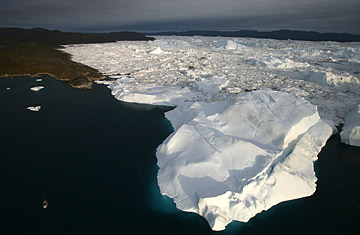
An aerial view of icebergs as they float out of the Jacobshavn Fjord into Jacobshavn Bay, near Ilulissat, Greenland
Why sumo wrestlers cheat, why drug dealers are poor, the socioeconomic patterns of naming children — the book Freakonomics brought economic analysis to bear on unexpected and quirky issues and came up with unexpected and quirky answers. It's little surprise, then, that the 2005 book — by University of Chicago economist Steven Levitt and New York Times journalist Stephen Dubner — sold more than 3 million copies worldwide.
Numbers like that demand a sequel, and this month Levitt and Dubner delivered theirs: SuperFreakonomics: Global Cooling, Patriotic Prostitutes and Why Suicide Bombers Should Buy Life Insurance. But while their first book focused mostly on smaller stuff, SuperFreakonomics takes on one very big subject — global warming — and it has got environmentalists and climate scientists across the blogosphere feeling dismayed by the Freaky Ones.
What's the problem? For starters, Levitt and Dubner begin their chapter on climate change by citing the concerns over the risk of global cooling, which were held briefly by some scientists in the early 1970s — that's a common trope for climate contrarians, who say that if concerns over cooling turned out to be false, maybe the same thing will come of the current worries over global warming. They go on to question the accuracy of today's climate models, and by extension, whether we should really be concerned about potentially catastrophic temperature increases over the coming century. They further point out that plants may indeed thrive in a future with higher carbon dioxide levels — after all, greenhouses pump in extra CO2 to encourage growth — but they fail to note that hotter summers and increasing droughts could threaten agriculture. They assert that sea levels can rise only 1.5 ft. over the coming century, ignoring the very real risk of accelerated melting of the Greenland and Antarctic ice sheets, which would multiply that number. They downplay the risks of carbon dioxide as a greenhouse gas. And they make a habit of referring to any climate scientist who expresses fear over a warmer future as a "doomsayer" — a bit of a loaded term.
I could go on — and readers who want to immerse themselves in the remarkably detailed pissing match can follow it on Climate Progress or the Freakonomics blog. But if you want my moderately informed take on SuperFreakonomics' climate-change chapter, I think Levitt and Dubner went into it with a contrarian mind-set, which saturated their interpretation of existing climate-change science. In doing so, they vastly underplayed the real risks posed by global warming.
Still, Levitt and Dubner do tackle one legitimately controversial topic, one that I think could benefit from a somewhat contrarian perspective: geoengineering, or using technology to directly cool the earth to compensate for man-made climate change. The authors visit Nathan Myhrvold, the brilliant former chief technology officer of Microsoft and co-founder of Intellectual Ventures, a private think tank. Myhrvold and his staff have the idea to build a giant "garden hose to the sky" that would pump liquefied sulfur dioxide into the atmosphere. Scientists know that increasing SO2 in the air deflects sunlight, which cools down the earth; when Mount Pinatubo in the Philippines exploded in 1992, for instance, the SO2 sent into the atmosphere created a brief global cooling spell. Levitt and Dubner advocate pursuing this geoengineering scheme, which could potentially avert a hotter world for pennies on the dollar, compared with the long-term work of shifting to a low-carbon economy.
That wouldn't be a bad idea, except, as many environmentalists and climatologists are quick to point out, we don't know what the potential side effects of geoengineering might be or whether the entire operation would backfire badly. Geoengineering might be a cheaper option, but followed out to at least one logical conclusion, it could be a pitfall. Say we try to use Myhrvold's giant-garden-hose scheme (after hopefully giving it a better name) without reducing carbon emissions. We could end up in a situation in which we can't abandon geoengineering without risking sudden, disastrous warming due to unchecked CO2 emissions. Then, what was meant to be a quick, cheap fix would turn out to be a trap. And while Levitt and Dubner say the fix is appealing at least in part because it's politically impossible to imagine the world agreeing on a common carbon cap — pointing to the problems with the Kyoto Protocol — in reality, the geopolitics of geoengineering are even tougher. Would the world stand idly by if China unilaterally decided to begin geoengineering our collective climate? What if the U.S. did? And even if we did allow geoengineering to commence, could we agree on what an acceptable global temperature would be?
Levitt and Dubner included in their book input from Ken Caldeira, an ecologist at Stanford University who has made no secret of his research into the possible effectiveness of geoengineering schemes — even as many of his colleagues have shied away from the subject, partly out of concern that it would wrongly convince people that there is a cheaper way to counter global warming. Since SuperFreakonomics was published, however, Caldeira has claimed that Levitt and Dubner mischaracterized his views. He says he's in favor of researching geoengineering in order to gauge its effectiveness and its potential side effects, but he still believes it should only be used, if at all, as a measure of last resort. In the meantime, we must continue to work to reduce carbon emissions over the long-term.
Ultimately, that is the right way to use geoengineering and to approach climate change. While geoengineering shouldn't be ignored, Levitt and Dubner's biggest mistake in their examination of the topic lay in being seduced by a clever-sounding, cheap and contrarian shortcut. Climate change, however, is one issue for which the conventional wisdom still works, even though it's costly — and even though conventional wisdom won't sell 3 million books.
